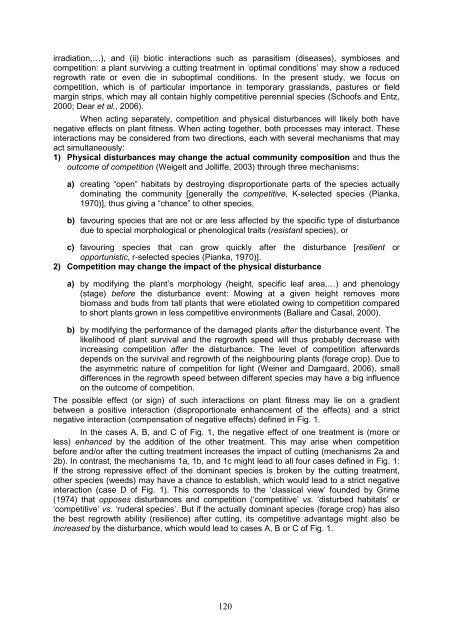Diversifying crop rotations with temporary grasslands - Université de ...
Diversifying crop rotations with temporary grasslands - Université de ...
Diversifying crop rotations with temporary grasslands - Université de ...
You also want an ePaper? Increase the reach of your titles
YUMPU automatically turns print PDFs into web optimized ePapers that Google loves.
irradiation,…), and (ii) biotic interactions such as parasitism (diseases), symbioses and<br />
competition: a plant surviving a cutting treatment in ‘optimal conditions’ may show a reduced<br />
regrowth rate or even die in suboptimal conditions. In the present study, we focus on<br />
competition, which is of particular importance in <strong>temporary</strong> <strong>grasslands</strong>, pastures or field<br />
margin strips, which may all contain highly competitive perennial species (Schoofs and Entz,<br />
2000; Dear et al., 2006).<br />
When acting separately, competition and physical disturbances will likely both have<br />
negative effects on plant fitness. When acting together, both processes may interact. These<br />
interactions may be consi<strong>de</strong>red from two directions, each <strong>with</strong> several mechanisms that may<br />
act simultaneously:<br />
1) Physical disturbances may change the actual community composition and thus the<br />
outcome of competition (Weigelt and Jolliffe, 2003) through three mechanisms:<br />
a) creating “open” habitats by <strong>de</strong>stroying disproportionate parts of the species actually<br />
dominating the community [generally the competitive, K-selected species (Pianka,<br />
1970)], thus giving a “chance” to other species,<br />
b) favouring species that are not or are less affected by the specific type of disturbance<br />
due to special morphological or phenological traits (resistant species), or<br />
c) favouring species that can grow quickly after the disturbance [resilient or<br />
opportunistic, r-selected species (Pianka, 1970)].<br />
2) Competition may change the impact of the physical disturbance<br />
a) by modifying the plant’s morphology (height, specific leaf area,…) and phenology<br />
(stage) before the disturbance event: Mowing at a given height removes more<br />
biomass and buds from tall plants that were etiolated owing to competition compared<br />
to short plants grown in less competitive environments (Ballare and Casal, 2000).<br />
b) by modifying the performance of the damaged plants after the disturbance event. The<br />
likelihood of plant survival and the regrowth speed will thus probably <strong>de</strong>crease <strong>with</strong><br />
increasing competition after the disturbance. The level of competition afterwards<br />
<strong>de</strong>pends on the survival and regrowth of the neighbouring plants (forage <strong>crop</strong>). Due to<br />
the asymmetric nature of competition for light (Weiner and Damgaard, 2006), small<br />
differences in the regrowth speed between different species may have a big influence<br />
on the outcome of competition.<br />
The possible effect (or sign) of such interactions on plant fitness may lie on a gradient<br />
between a positive interaction (disproportionate enhancement of the effects) and a strict<br />
negative interaction (compensation of negative effects) <strong>de</strong>fined in Fig. 1.<br />
In the cases A, B, and C of Fig. 1, the negative effect of one treatment is (more or<br />
less) enhanced by the addition of the other treatment. This may arise when competition<br />
before and/or after the cutting treatment increases the impact of cutting (mechanisms 2a and<br />
2b). In contrast, the mechanisms 1a, 1b, and 1c might lead to all four cases <strong>de</strong>fined in Fig. 1:<br />
If the strong repressive effect of the dominant species is broken by the cutting treatment,<br />
other species (weeds) may have a chance to establish, which would lead to a strict negative<br />
interaction (case D of Fig. 1). This corresponds to the ‘classical view’ foun<strong>de</strong>d by Grime<br />
(1974) that opposes disturbances and competition (‘competitive’ vs. ‘disturbed habitats’ or<br />
‘competitive’ vs. ‘ru<strong>de</strong>ral species’. But if the actually dominant species (forage <strong>crop</strong>) has also<br />
the best regrowth ability (resilience) after cutting, its competitive advantage might also be<br />
increased by the disturbance, which would lead to cases A, B or C of Fig. 1.<br />
120

















